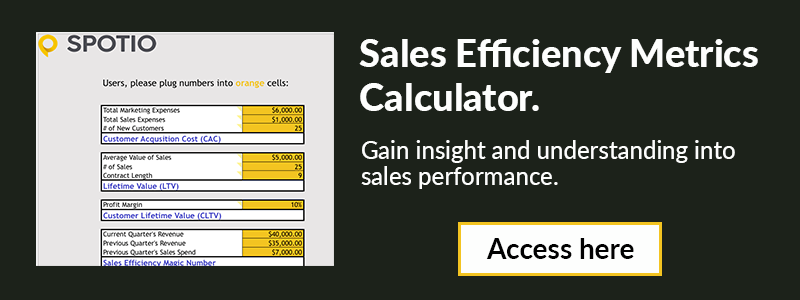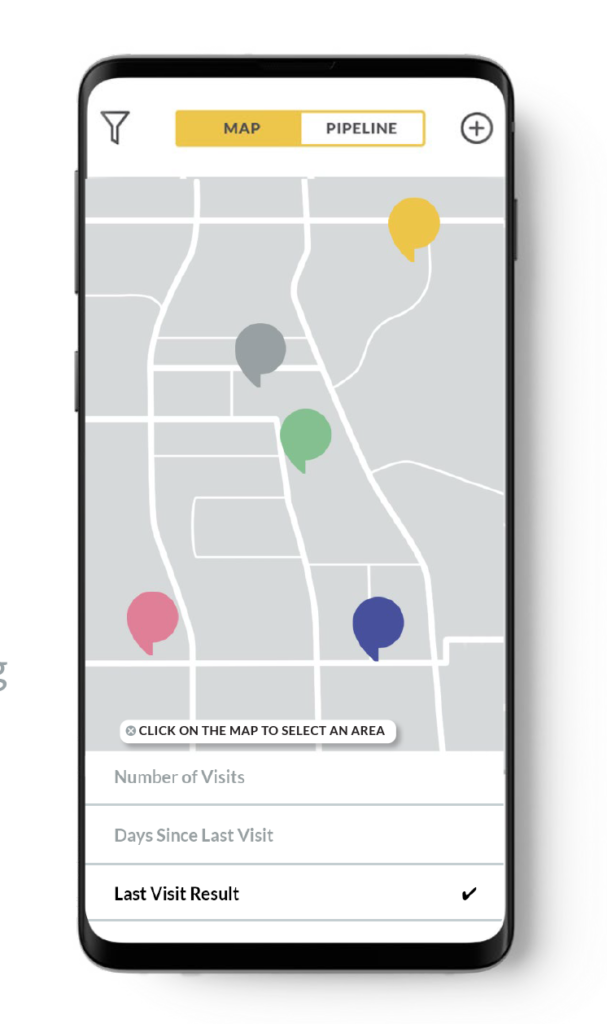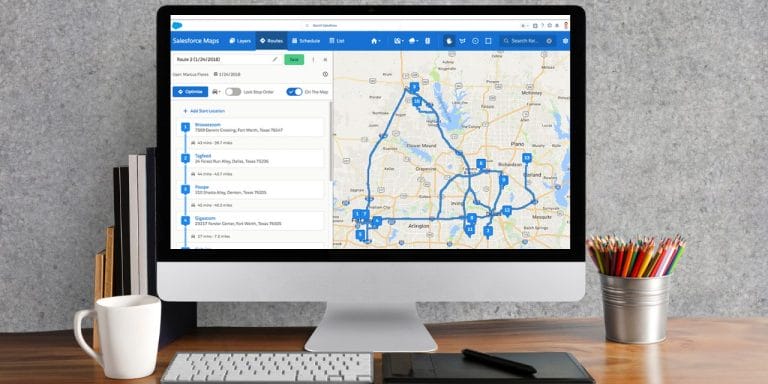Every sales manager dreams of a full pipeline, but generating more sales is only part of the equation. While sales effectiveness focuses on improving conversions, there’s another critical component that deserves your attention: sales efficiency.
Sales efficiency is the secret to not only increasing revenue but also streamlining your sales processes to achieve faster results with fewer resources. In 2025, AI is playing a pivotal role in enhancing efficiency by automating tasks, analyzing data, and delivering actionable insights that empower sales teams to work smarter.
In this guide, we’ll explore what sales efficiency is, why it’s essential for your business in 2025, and 12 actionable strategies—including AI-driven solutions—to make your sales process more efficient than ever.
What is Sales Efficiency?
So, what is sales efficiency? How is it different from sales effectiveness?
Let’s explore the definitions.
Sales Efficiency vs. Sales Effectiveness
Sales effectiveness refers to your sales team’s ability to convert prospects into leads — and eventually paying customers or clients — at each stage of your sales funnel. If your sales process is effective, you will experience more “wins” than losses every step of the way.
Sales efficiency refers to the speed of your sales operations. That is, how quickly you are able to convert users into leads/sales and while still generating the highest return on your investment. It is the revenue your sales team generates relative to the cost.
A sales process that is both efficient and effective will help reps close sales in a reasonable time frame, at a sustainable cost, and on the right terms.
Why Sales Efficiency & Effectiveness Should Be Your #1 Priority
Your sales team closing the majority of new prospects isn’t always an indication of success.
While sales quotas continue to rise, only 47% of B2B sales organizations hit their targets. The fact that the average sales rep only spends 39% of their time selling. As such, sales efficiency is key.
Calculating your sales efficiency is the best way to determine whether your business is on track. If there’s room for improvement, you will need both sales efficiency and sales effectiveness to move the revenue needle.
How Do You Calculate Sales Efficiency?
Here’s a simple formula you can use to calculate sales efficiency in a specific period:
Sales Efficiency Ratio = Sales Revenue / (Sales and Marketing Costs)
Sales and marketing costs include staff salaries, costs for software and tools, lead generation activities such as advertising, office expenses, training, and more.
For instance, if you earn $80,000 in new Q2 revenue and spend $40,000 on sales and marketing in that quarter, your efficiency score is 2.
Your sales process is efficient if your score is 2 or higher. A score of 1 indicates that your company is essentially breaking even, and a score of less than 1 means you’re spending more than you’re earning.
What is a Good Sales Efficiency Ratio?
A good sales efficiency ratio is between one and three. In other words, it should take your company 4 to 12 months for revenue to cover sales and marketing costs. If your company’s number is lower than this, you need to increase efficiency. If it’s higher, your sales team is on fire. Keep doing what you’re doing!
12 Ways to Improve Sales Efficiency
Sales efficiency is the backbone of a successful business. It’s not just about generating more sales but doing so faster and with fewer resources.
Below are 12 actionable strategies to improve sales efficiency, updated for 2025 with insights on how AI can play a transformative role.
1. Set Business Goals and KPIs
Setting clear business goals and measurable KPIs is fundamental to driving sales efficiency and ensuring alignment across teams. Traditional techniques, such as the SMART goals framework, remain highly effective for defining objectives that are Specific, Measurable, Achievable, Relevant, and Time-bound. For example, you might set a goal for sales reps to close a specific number of deals per month or achieve a target revenue per sale. These methods provide clarity and focus, making it easier to track progress and adjust strategies as needed.
Communicating these goals to your team is equally important. Ensure that expectations are clearly outlined from the start—whether it’s hitting monthly sales quotas or maintaining customer retention rates. Regular check-ins and performance reviews can help reinforce accountability while providing opportunities to refine objectives based on real-world results. This collaborative approach keeps everyone aligned and motivated toward shared success.
AI tools can complement traditional goal-setting techniques by analyzing historical performance data and identifying patterns that inform realistic targets. Predictive insights from AI can help businesses anticipate outcomes and optimize KPIs for greater accuracy. For instance, AI might reveal trends in customer behavior or sales cycles that influence how goals are set. By combining traditional methods with AI-driven enhancements, organizations can create a balanced strategy for achieving both short-term wins and long-term growth.
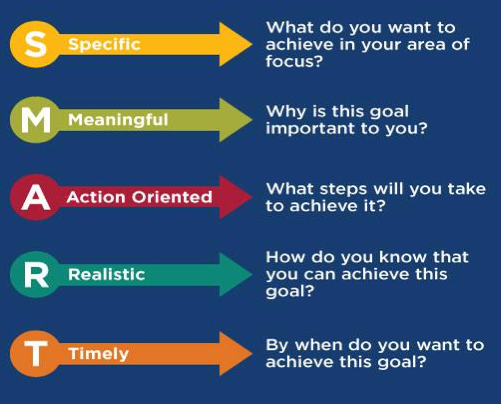
For example, your goal could be: Increase sales by 17% by the end of the next quarter.
Once you are clear on what your goals are, and what KPIs you’ll use to measure success, make sure you track sales activity closely. Identify any bottlenecks and fix problems in a timely manner to improve sales efficiency.
2. Identify Your Ideal Customer
As much as half of sales time is wasted on unproductive prospecting. To make sure you’re going after the right prospects, create an ideal customer profile (ICP) that defines your most valuable and likely-to-convert customers.
A complete ICP should include the following components:
- Demographics: Age, gender, job title, income level, or other personal attributes.
- Location: Geographic region or market where your customers are based.
- Needs and Pain Points: Challenges, goals, or problems your product or service can solve.
- Firmographics: Company size, industry, and revenue for B2B customers.
- Behavioral Attributes: Purchasing habits, decision-making processes, and brand loyalty.
A well-defined ICP helps your sales team focus on the right prospects, craft tailored messaging, and avoid wasting time on irrelevant leads. It ensures alignment across sales and marketing efforts while improving conversion rates and customer satisfaction.
Sales intelligence tools like SPOTIO’s Lead Machine make it easy to define your ICP with over 200 data points, including demographics, location, and contact information.
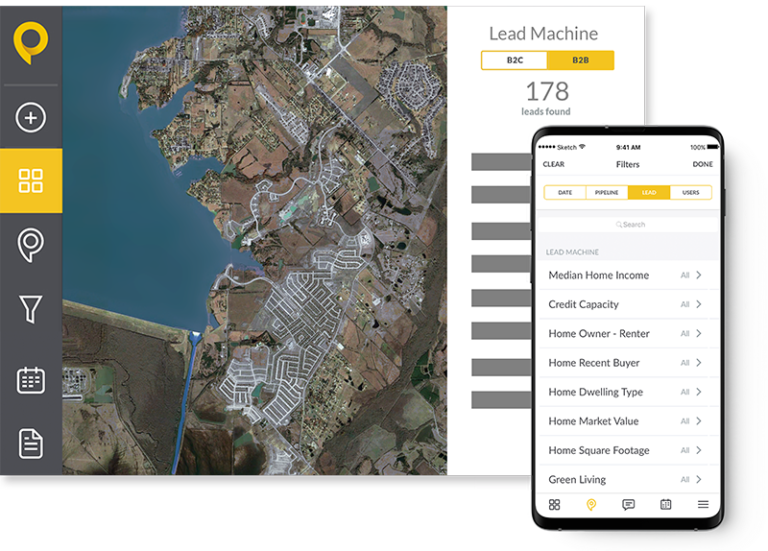
3. Create a Repeatable Sales Process
If you want your sales team to be efficient, you need to establish a repeatable, consistent sales process. Having a go-to guide for qualifying leads, selling at the right moment, collaborating with the team, and other important sales tasks will help reps work smarter and faster.
The key steps in a sales process include:
- Preparation & Research: Know the scope of your product, your ideal customer’s wants and needs, and your company’s unique selling point.
- Prospecting: Identify potential customers and move them through your sales funnel. AI-powered sales tools can analyze detailed customer data to help you focus on the most promising prospects.
- Needs Assessment: Dig deeper into what the prospect needs and what issue(s) they are trying to solve. That way, reps can custom-tailor a solution for them.
- Pitch & Presentation. Communicate the value of your product to the customer while building trust. Focus on benefits that align with the customer’s pain points and present your product as the ideal solution.
- Objection Handling: Addressing questions or concerns to establish trust and differentiate your product or service from your competitors.
- Closing: Finalize the sale or send the proposal.
- Follow-Up. Referrals are the highest converting lead source. Follow-up with customers to encourage referrals and repeat business.
Creating a tailored sales process for each prospect can be time-consuming. Tools like SPOTIO Autoplays simplify this by automating outreach sequences for each prospect and funnel stage to ensure no lead falls through the cracks.
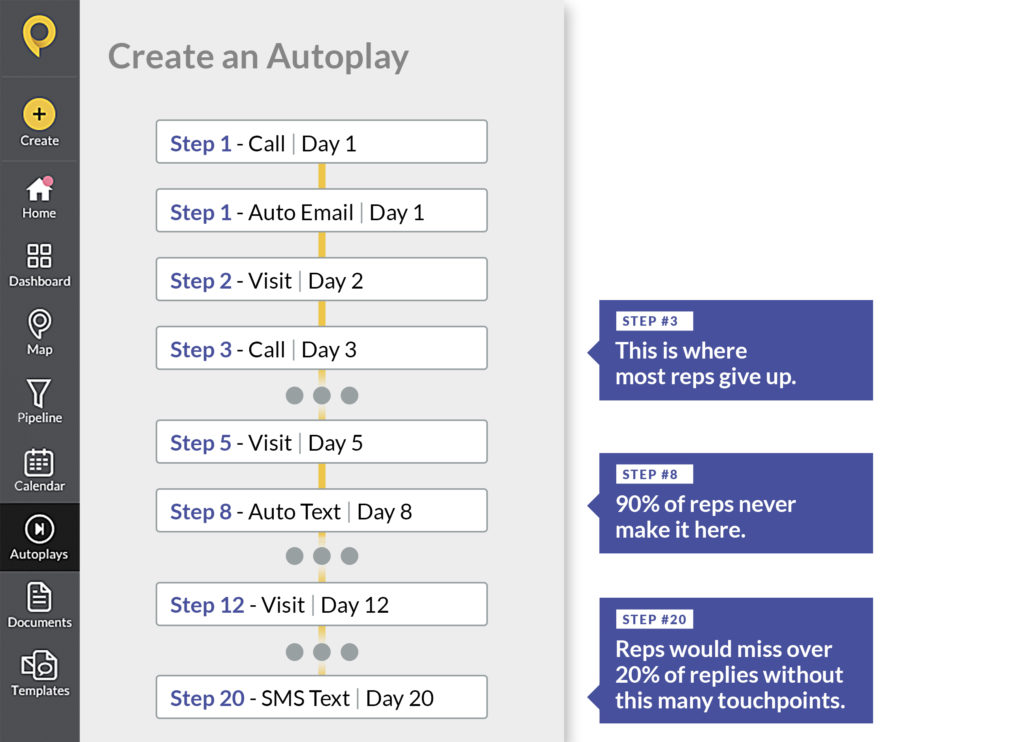
Creating a clear sales process ensures that reps are following the same step at every stage, and it helps pinpoint holes in the process. If leads are dropping off right before the close, you will be able to see this issue and address it quickly.
4. Define Daily, Weekly and Monthly Sales Activities
Sales activities are routine steps that keep your pipeline full and your team productive. These tasks include:
Daily Sales Activities
These are the foundational tasks that keep the pipeline moving and ensure reps are prepared for the day ahead:
- Contacting new prospects (via calls, emails, or in-person visits).
- Following up on previous meetings or inquiries.
- Pitching solutions to qualified leads.
- Reviewing and optimizing routes for in-person visits using route-planning software.
- Logging customer interactions and updates into CRM systems.
- Scheduling follow-ups or next steps for leads and customers.
- Preparing for upcoming meetings by reviewing customer notes or account details.
Weekly Sales Activities
These focus on planning, collaboration, and assessing progress:
- Planning the week ahead, including setting up meetings and mapping territories.
- Reviewing performance metrics (e.g., number of calls made, meetings scheduled, deals closed).
- Attending team meetings to discuss goals, challenges, and updates.
- Collaborating with marketing teams to align on lead generation strategies.
- Conducting prospecting activities to identify new opportunities.
- Evaluating pipeline health to identify bottlenecks or stalled deals.
Monthly Sales Activities
These activities are geared toward strategic planning and long-term growth:
- Reviewing monthly performance reports to assess progress toward goals.
- Adjusting sales strategies based on data-driven insights from AI tools.
- Conducting account reviews for key clients to identify upsell opportunities.
- Training sessions to improve skills or learn about new tools and techniques.
- Refining sales territories based on performance data and market changes.
While these activities are essential, they can also be time-consuming and repetitive. AI-powered tools and virtual agents are revolutionizing how sales teams handle these tasks by automating routine activities. For example, AI can schedule follow-ups, update CRM records, and even analyze customer data to prioritize high-value leads—all without manual intervention. This automation not only saves time but ensures consistency across daily workflows.
5. Align Sales and Marketing Teams
Often, miscommunication between marketing and sales teams causes inefficiency.
In fact, only 35% of salespeople think that the marketing team knows what content they need, and only a third of sales and marketing teams talk regularly. This is obviously a problem.
When marketing and sales teams are on different pages, the entire company suffers. For example, sales reps might not understand how marketing talks about products. And the handoff from one department to the other often lacks context, which enables sales reps to make sales at a consistent clip.
Fortunately, aligning both teams can solve these kinds of issues. Here’s how to do it:
- Create Shared Goals: Marketing and sales teams should work towards common objectives. A single objective, such as company revenue, will help ensure marketing and sales alignment.
- Build Personas Together: If your marketing and sales teams have different buyer personas, you’re going to have issues. Ask both departments to create unified personas. That way marketing produces the kinds of leads that sales can actually close on a regular basis.
- Commit to Communication: Finally, make sure marketing and sales professionals talk every month—if not every week. Is marketing able to generate the right kind of leads? Does sales need to change their approach based on marketing’s strategy? These are important questions. By communicating on a regular basis, you’ll be able to answer them and improve revenue.
6. Train Your Sales Reps Effectively
Did you know that 71% of B2B buyers feel that sales reps lack adequate knowledge of their business needs? This gap in preparation can lead to wasted time, missed opportunities, and longer sales cycles.
Without proper training, sales reps may rely on ineffective strategies, pitch too early, or struggle to handle objections. To avoid these pitfalls, sales managers should require new hires to complete comprehensive training on prospecting, selling techniques, and customer engagement. Training should also address common challenges reps face and provide actionable tips for overcoming objections.
Ongoing training is just as important. It helps your team stay up-to-date on the latest sales techniques and tools. For example, AI-powered coaching platforms like Gong or Chorus analyze sales calls to provide real-time feedback, helping reps refine their skills and improve performance continuously.
By investing in both initial and ongoing training—and leveraging AI tools for personalized coaching—you can ensure your team is always prepared to meet the demands of a competitive market.
7. Assign Sales Territories Strategically
Strategic rep assignment is one of the best ways to prevent redundancies in your sales process. It ensures that sales reps aren’t targeting the same areas or leads simultaneously, which can waste time and resources.
To maximize efficiency, assign your top-performing reps to the most lucrative territories. This approach increases the likelihood of closing high-ticket deals and ensures your team’s efforts are focused on areas with the greatest potential for revenue growth. For additional tips For additional tips, check out our guide on Sales Territory Management.
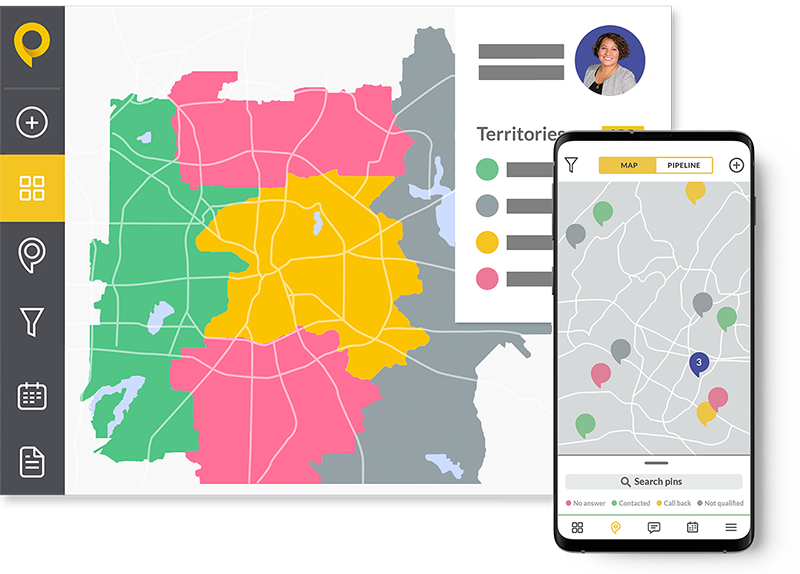
Image: Screenshot of the SPOTIO territory management interface.
SPOTIO’s Territory Management software simplifies this process by allowing managers to create clear territory plans using geographic boundaries or custom-drawn maps. The platform provides performance insights for each territory, helping you identify high-performing areas and allocate resources strategically. With features like hierarchical permissions and customizable reporting, SPOTIO ensures teams stay organized, productive, and focused on their assigned territories.
By leveraging tools like SPOTIO, you can streamline territory management, eliminate overlap, and help your team operate more efficiently within their designated areas.
8. Reduce Windshield Time
Driving from meeting to meeting has a huge impact on a rep’s daily efficiency. Mapping efficient routes maximizes the amount of time reps spend selling and reduces their time on the road.
Route planning software is the best way to reduce driving time for reps when they’re in the field. You can use it to:
- Cut down windshield time
- Easily find the most efficient route to one or multiple meetings
- Map and plan your day in a single tap
9. Sell to Customer Needs
The research you conducted on your ideal customer profile provides critical insights into what your potential customers are struggling with, what they need, and what they want. By understanding their pain points and clearly articulating how your product solves their problems, you can position yourself as the obvious choice.
While competitors may focus on showcasing every feature of their products, you can stand out by speaking directly to your target customer’s strongest pain points. This approach builds trust and demonstrates that you truly understand their challenges. If you effectively highlight the benefits of your solution and show how it meets their needs, closing the sale becomes much easier.
As mentioned earlier, AI-powered tools like Gong or Chorus can further enhance this process by analyzing customer conversations in real time. These platforms identify key pain points mentioned during calls and suggest tailored responses or solutions, helping reps address customer needs more effectively. By leveraging AI insights, your team can refine their messaging and ensure every pitch resonates with the prospect.
Selling to customer needs isn’t just about offering a product—it’s about showing that you have the perfect solution to solve their problems.
10. Manage and Nurture Leads Effectively
Nurtured leads produce, on average, a 20% increase in sales opportunities versus non-nurtured leads.
It’s always easier to sell to a “warm” lead — someone who is familiar with your brand and has been primed for the sale — than a “cold” one. That’s why it’s essential to have a lead nurturing process.
The best system for doing this is a centralized CRM or lead management system. This software allows your sales team to see where prospects are at in the sales cycle so that they can follow up with them in the right way at the right time.
A CRM tool will increase sales efficiency by:
- Notifying your team when to follow up
- Helping your team tailor communications to where prospects are in the sales cycles
- Assigning priority to prospects that are farther down the sales funnel
11. Work on the Basics
Sometimes, the easiest and fastest way to improve sales efficiency is to revisit the fundamentals. No matter how long your business has been running or how refined your processes are, there’s always room for improvement.
Start by fine-tuning your sales process. Explore new ways to find prospects, present sales pitches, or conduct follow-ups. Even small adjustments can lead to big results. Don’t hesitate to reevaluate your current system from a fresh perspective—what worked yesterday may not be as effective today.
To get started, try using an AI prompt tailored to your specific challenges. For example, you could ask an AI such as ChatGPT, Claude, Gemini or Grok:
“Based on my CRM data for Q1 2025, what are three ways I can improve follow-up strategies to increase conversion rates?”
Provide the AI with input such as lead source, customer demographics, behavioral data, lead scoring, or conversion rate per segment to help it generate targeted recommendations. These insights can guide your team in refining their approach and addressing inefficiencies.
By focusing on the basics and leveraging AI for tailored guidance, you can ensure your team stays sharp, efficient, and ready to adapt in today’s ever-changing sales environment.
12. Maximize Rep Productivity
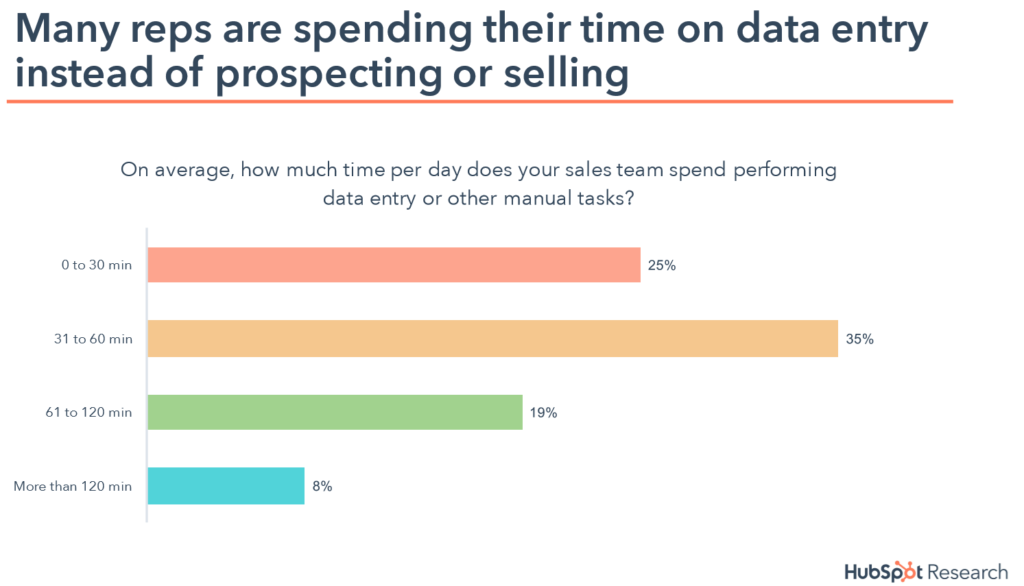
A 2023 study found that sales reps spend just 28% of their time on selling, with the rest consumed by non-selling tasks like traveling, attending meetings, or entering data. This imbalance highlights a major opportunity to improve productivity.
To help reps focus more on selling, leverage tools that streamline routine tasks. For example, the SPOTIO app allows reps to create notes in the field that automatically sync to your CRM, eliminating manual data entry at the end of the day. This automation saves valuable time and ensures reps can prioritize customer interactions.
Additionally, look for ways to automate other repetitive activities, such as scheduling follow-ups or updating records. AI-powered solutions can analyze workflows and recommend optimizations, like prioritizing leads based on engagement data or sending reminders for next steps. These tools free up reps to focus on what matters most—building relationships and closing deals.
By adopting automation tools and refining workflows, you can help your team reclaim valuable selling time and boost overall productivity.
4 Sales Efficiency Metrics To Start Tracking
The goal of a sales team is to spend as much time as possible actively selling. To understand how efficient your current sales process is, track specific metrics that provide actionable insights. The four sales efficiency metrics below will help you identify areas for improvement and optimize your team’s performance.
1. Customer Acquisition Cost & Customer Lifetime Value
Cost of acquisition, or CAC, is an essential metric for understanding efficiency as it lets you know if your resources are being allocated in the best way. Here’s the formula for calculating CAC for a specific period:
CAC = Total Marketing Spend / # Of New Customers
Cost of acquisition, or CAC, is an essential metric for understanding efficiency as it lets you know if your resources are being allocated in the best way.
Next, you’ll want to calculate your customer lifetime value (CLTV). The closer these two numbers are, the more unsustainable your sales process is. It also goes without saying that your CAC shouldn’t exceed your LTV.
A good LTV:CAC ratio benchmark is 3:1
CLTV = Avg. Value Of Purchases x # of Sales x Contract Length
Tracking your average customer acquisition cost over time also helps your company make smart decisions.
2. Lead Response Time
How long does it take sales reps to respond to new leads? According to recent research, 88% of customers want an email response within one hour. So, efficient follow-up can be crucial to a sale.
If you find that certain sales reps are falling behind in response time, it may be time for retraining. If lead response times seem to be gradually increasing, that could be a sign that the workload per sales rep is too much, and you may need to hire additional help.
3. Number of Sales Calls Per Rep
While analyzing sales efficiency on a team-wide basis is useful, it only tells a partial story. You also need to track sales metrics such as the number of sales calls or visits per week per team member.
Taking into account pre-call research, the actual call, and post-call CRM updates, you should allow an average of 7.5 minutes for each cold call.
60 Minutes / 7.5 Minutes Per Call = 8 Cold Calls Per Hour.
This metric helps you assess performance, as well as team member strengths and weaknesses.
4. Frequency of Customer Contact
Building trust with the prospect is an important aspect of an optimized sales process. By tracking the rate of client outreach, you can make sure your team is putting in the right amount of time to create a long-lasting relationship.
You can also use this data to understand what sales tactics work best with your customers.You may find that more touch points convert better for certain customer personas.
Boost Your Sales Efficiency with SPOTIO
Sales efficiency is critical for businesses that want to close more deals and maximize the return on their sales investment. It’s not just about closing rates—true sales success comes from tracking the right metrics, optimizing processes, and empowering your team to work smarter.
Is your sales team operating as efficiently as it could be?
With SPOTIO, you can transform your sales operations. From qualifying prospects to streamlining processes, SPOTIO helps you improve efficiency at every stage of the sales cycle. Request your demo today to see how SPOTIO can help your team achieve more in less time.

